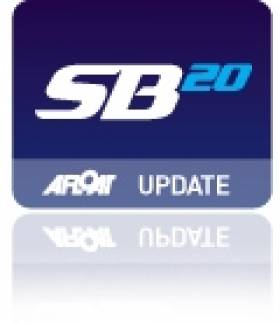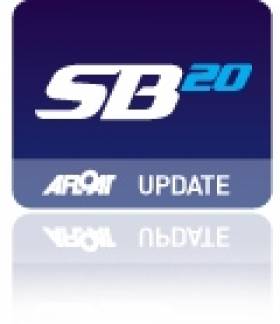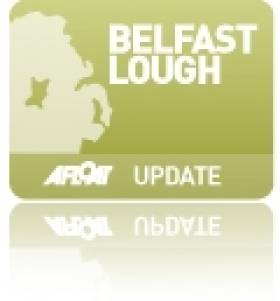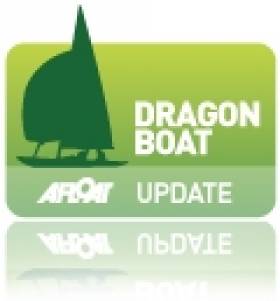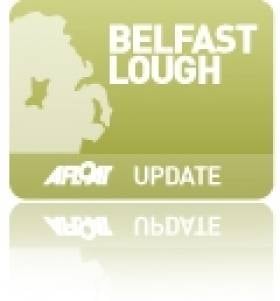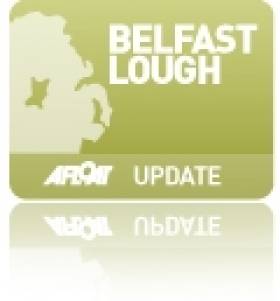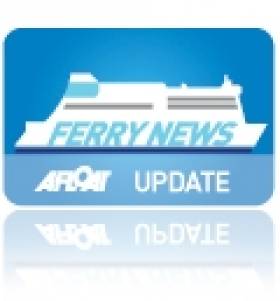Displaying items by tag: Belfast Lough
Duncan Leads SB20 Nationals in Belfast Lough
#sb20– Heavy rain and bad visibility greeted the SB20 fleet yesterday in Belfast Lough for day 1 of the Class Nationals. Wind from the south coming off the Ballyholme shore made for gusty and shifty racing for the fleet. Strangford Lough based former Flying fifteen champion Darren Martin started the series with a very impressive first place in race 1 in this highly competitive fleet. Local heroes Andrew & Ross Vaughan also consistently in the top 5 with a 4,5,4 showing the advantage of local knowledge.
However it was Ben Duncan again who showed a master class in one design racing with a 6,1,1 leading overnight by 4 points to Mel Collins (8,2,2). These leading two boats as expected battling it out at the front for race leader, each boat gaining and losing the advantage several times. On the final race, Collins only losing it out to Duncan on the final sprint to the finish as each boat split for different sides of the gate.
More to come today on Belfast lough where inclusion in the top 10 in this class is a hard fought thing.
1st - NZL 3287 -Duncan
2nd - IRL 3198 - Collins
3rd - IRL 3501- Martin
4th - IRL3298 - Vaughan
Squib Champion to Contest SB20 Title on Belfast Lough
#sb20 – Hosted this year by Royal Ulster Yacht Club this weekend's SB20 nationals in Belfast Lough, will feature up to 30 boats
Based at Bangor Marina, the eight race series will kick off on Friday lunchtime in what is looking likely to be a light airs and typically fickle Belfast lough event.
Fresh from his Squib National championship win, Aidan O'Connell on Ruby Blue will be keen to serve up back to back championship wins and is tipped as a hot contender for the title, however he does have to overcome the ever consistent Ben Duncan to achieve this. Based on recent form and speed, Aidan and his team will certainly be tipped for a podium finish.
Duncan however is coming off the back of a typically successful season having scored a Scottish National title, an SB20 Easterns, Westerns and Southerns title. His foray into the Dublin Bay sailing club scene resulted in an impressive string of 6 wins from 6 races.
Peter Kennedy and Stephen Kane from Belfast Lough are a team never to be underestimated however. A win on home waters this season for the Northerns title shows that the northerners have the potential to upset. Local Hero Brian Spence and Gareth Flannigan will both be on the water. Although not recently active in the class, both northerners will be keen to assert their influence on the leader board once again.
From the West, Sligo based Brian & Paul Reilly on BMW Boomsticks and Cork based Scott McKeown onboard Magic helmed by Mel Collins will be up for this event, with a few near misses this season, both crews will be hungry for this event and will certainly do damage to the scoreboard and look to upset the table.
Also attending is the formidable team of Emmet and James Ryan, recent RS400 National title winners. The pair have been going from strength to strength in the RS class and will be tipped to cut a dash in the SB's.
Belfast Harbour Gets New Wind Turbine Building Hub
#BELFAST LOUGH NEWS - A new hub for wind turbine manufacturing at Belfast Harbour is expected to the completed by the end of this year, as the Belfast Telegraph reports.
The 50-acre reclaimed site on the shores of Belfast Lough chosen by Danish energy company DONG has apparently been kept vacant or more than 50 years awaiting the right development.
When operational early next year, the new 'offshore wind logistics terminal' - which will produce wind turblines for the West of Duddon Sands Wind Farm in the Irish Sea off Cumbria in north-west England - is expected to create 300 jobs in the growing renewable energy sector. Meanwhile, 150 workers will be needed for the construction phase.
A spokesperson for Belfast Harbour described the £50 million (€63.2 million) project as "the largest ever in Belfast Harbour's 400-year history" and "a major vote of confidence" in the harbour's long-term investment strategy.
The Belfast Telegraph has more on the story HERE.
#BELFAST LOUGH - The Ulster Wildlife Trust has announced details of a coastal walk around Belfast Lough next Thursday ahead of the August Bank Holiday weekend.
The guided coastal walk will follow the picturesque coastal toe-path from Whitehead Harbour to Blackhead, led by Kerri Whiteside from the trust's Living Seas Team and Ben Simon, biodiversity officer with Carrickfergus Borough Council.
The leisurely walk will stop en-route at various points to investigate the rocky, sandy, cobbly and muddy shores where seaweed, sea shells and anemones are waiting to be discovered.
The walk will depart from Whitehead Harbour in Larne, Co Antrim at 3pm on Thursday 2 August. Booking is not required for this free event, which is part of the celebrations for the UK's National Marine Week.
#BELFAST LOUGH NEWS - Belfast Lough Sailability was selected to host the Irish Paralympic Sailing Team for their pre-event training last weekend from 28 June to 1 July.
According to a spokesperson, the move "definitely puts Carrickfergus Marina and the Borough of Carrickfergus on an international platform with regard to elite sailing" - and comes after a call to the public to vote for the disabled sailing charity in the UK's National Lottery Awards.
It also provided a much-needed boost to the area after the recent fire that destroyed Carrickfergus Sailing Club.
The combination of state-of-the-art facilities at Carrickfergus Marina and the expertise of staff at Belfast Lough Sailability ensured that the Irish athletes had an exciting and challenging training camp ahead of the Paralympic Games, which take place after the London Olympics later this summer.
Belfast Lough Sailability said their hosting of the team "acknowledges that Carrickfergus is capable of offering access for training at the highest level of sailing competition for the disabled".
The paralympians were also wished great success in their campaign by Miss Northern Ireland Tiffany Brien, who happens to be an Olympic Class sailor and ambassador for Belfast Lough Sailability.
Jim Boyd, chair of Belfast Lough Sailability, said: “I believe that this is only the start, and potentially teams from further afield will be using our combined expertise to train in the best sailing waters in the UK, at a five-anchor marina already strongly committed to supporting disabled sailing.
"In partnership with Carrickfergus Borough Council, Belfast Lough Sailability are now recognised as leaders in sailing for people with disability and together we can go from strength to strength.”
'Land of Giants' Spectacle at Titanic Belfast
#BELFAST LOUGH – The largest outdoor arts event ever seen in Northern Ireland is to take place tonight in Belfast at the iconic landmark venue of the £100m Titanic Belfast, writes Jehan Ashmore.
The spectacle is a combination of acrobatics, aerial dance, carnival, circus, music, multi-media and pyrotechnics. An audience of more than 20,000 people will be part of the 'Land of Giants' which takes its inspiration from 'giants' that are present in Northern Ireland's history, both ancient and modern.
Special focus will be given to four: Finn McCool, the giant who built the Giant's Causeway; Gulliver, whose giant features are outlined in the hills surrounding Belfast; Samson and Goliath, the two cranes that have dominated the Belfast skyline for the past 40 years; and the Titanic, together with her less famous sister ship, the Olympic.
This evening's event of theatre and performance is part of the Legacy Trust UK Community Celebrations and the London 2012 Festival, a 12 week UK-wide cultural celebration for the London 2012 Olympic and Paralympic Games.
#DRAGON – Dublin's Martin Byrne is taking on a double Olympic gold medal winner and former world champion to defend his Dragon Edinburgh Cup title in the first week of July. Byrne, the Commodore of the Royal St. George Yacht Club in Dun Laoghaire, leads a strong international field of sailors travelling to Belfast to take part in what is set to be one of the largest Dragon Class yachting events of its kind. Sponsored by Belfast Harbour, Royal North of Ireland Yacht Club is hosting the 2012 Edinburgh Cup, the UK Dragon Championships, which will take place on Belfast Lough from 4th July-7th July.
Forty-six boats from 10 different countries, including Australia, Japan and Monaco, will compete in what is the largest field in 25 years as the international race returns to Northern Ireland for the first time since 2000. The event will see Denmark's Poul Ricard Hoj Jensen, who struck sailing gold in the Soling class at the 1976 and 1980 Olympics, pit his wits against Byrne and a strong Irish fleet including current Miss Northern Ireland Tiffany Brien, an experienced sailor who was ranked number one in Ireland in the single handed Laser Radial Class last year. Tiffany is crewing for Julian Sowry, one of the top UK competitors.
A former Edinburgh Cup winner, in addition to his world and Olympic successes, Jensen is excited about returning to a race course he rates very highly, saying:
"I am very much looking forward to taking part in the Edinburgh Cup in Belfast, I have sailed there numerous times before and the sailing area and race course are outstanding – in fact, it would be difficult to find a better race track anywhere in the UK.
"I have not yet seen the new marina constructed by Belfast Harbour and look forward to seeing the facility. I am also very well acquainted with the hospitality of the Royal North of Ireland Yacht club and I am excited about meeting up with 'old friends' and enjoying the social activities during the event."
The Edinburgh Cup will be preceded by the British Northern Area Championships from 1st July-3rd July, also hosted by Royal North of Ireland Yacht Club. A parade of sail involving over 30 competing Dragon class yachts will take place from Belfast Harbour's new marina facility at Abercorn Basin to the finish line at Royal North on Saturday evening (6pm) to launch both sailing competitions.
Simon Brien, of Royal North of Ireland and father of Tiffany Brien, commented:
"The calibre of entries for the Edinburgh Cup is truly exceptional and, given that we will have up to 10 different nationalities represented, I don't think there has ever been a sailing event in Northern Ireland with such a high quality international fleet. Challenging Poul Ricard Hoj Jensen for the title is a real who's who from the international yachting elite, with current world champion, Lawrie Smith, and Edinburgh Cup holder, Martin Byrne, also coming to take part.
"It's a real coup for Royal North to have such a stellar line-up and we would like to thank principal sponsor Belfast Harbour, whose support has been invaluable in ensuring we are able to host an event befitting the high calibre of participants. As ever, there is a varied programme of entertaining social events to accompany the competitive action and I would encourage people to come along and watch some world-class international Dragon class yacht racing."
In 2010, Royal North hosted the Irish Dragon Championships, also sponsored by Belfast Harbour, which attracted boats from throughout the UK and Europe. Looking forward to the Edinburgh Cup and British Northern Area Championships, Roy Adair, CEO of Belfast Harbour, commented:
"Belfast Harbour has strong historical links with the Royal North of Ireland Yacht Club and, following the great success of the Irish Dragon Boat Championships both on and off the water in 2010, we are delighted to once again form a partnership in hosting one of the most prestigious Dragon yacht racing events in the world.
"Just last month over 60 yachts from across Ireland enjoyed the new marina facilities at Belfast Harbour during our Lough to Lagan Floatilla and we are looking forward to welcoming international competitors and their families to Belfast once again. Tourism has been a major driver of the Northern Ireland economy – sailing, and the Edinburgh Cup in particular, adds another layer to Northern Ireland's tourism offering."
#BELFAST LOUGH NEWS - The Carrick Advertiser reports that disabled sailing charity Belfast Lough Sailability has has won a place in the semi-finals of the UK's National Lottery Awards 2012.
Voting opened yesterday in the annual scheme, and the group - one of only 10 projects to make it through in the Best Sports Project category - is calling on the public for its support.
The news comes a year after the charity received £50,000 from the Big Lottery Fund's People's Millions award which enabled the funding of the Sea Rover, a specially adapted vessel with a drop-down bow that enables access for wheelchair users.
More recently, as reported on Afloat.ie, the group added the Hawk 20 keel boat to its fleet which can take up to six for experience on the water.
Geraldine Duggan, chair of Belfast Lough Sailability said: "We're delighted to have reached the semi-finals of The National Lottery Awards and it's a superb acknowledgement for our staff and volunteers.
“With National Lottery funding, Belfast Lough Sailability was able to branch out, diversify and offer so much more to the community. We are a small organisation but we make a huge difference to the lives of those living with disability."
The Carrick Advertiser has more on the story HERE.
Belfast Lough Sailability Names Latest Vessel in its Fleet
#BELFAST LOUGH NEWS - The Hawk 20 was officially named in a ceremony hosted by Belfast Lough Sailability last weekend.
The Carrick Times reports that the disabled sailing charity's latest vessel can take up to six for experience on the water.
“The Hawk has a roomy comfortable cockpit and is a stable sailboat well suited for the task of taking people with disability out on the water," said Christine Harper, the charity's hon secretary.
The keel boat is set to join the other specially adapted vessels in the fleet for Belfast Lough Sailability's regular Wednesday evening sessions from Carrickfergus Sailing Club.
Those boats include the unique Sea Rover, a drop-down bow vessel which was funded with £50,000 from the Big Lottery Fund's People's Millions award, as voted for by the general public in 2010.
The weekly sailings are open to everyone with a disability, their carers or family members.
#FERRY NEWS - The veteran Stena Line ferry Stena Caledonia was spotted on sea trials in Belfast Lough last weekend pending its possible sale.
As Irish Sea Shipping reports, ASDP Ferry of Indonesia is thought to have an interest in acquiring the passenger vessel.
Stena Caledonia was withdrawn late last year to make way for Stena's second 'Superfast' ferry on the Belfast-Cairnryan route, as previously reported on Afloat.ie.
Pete Hodson captured a number of photographs as she made her way around the lough on Sunday 27 May, which can be seen HERE.


























